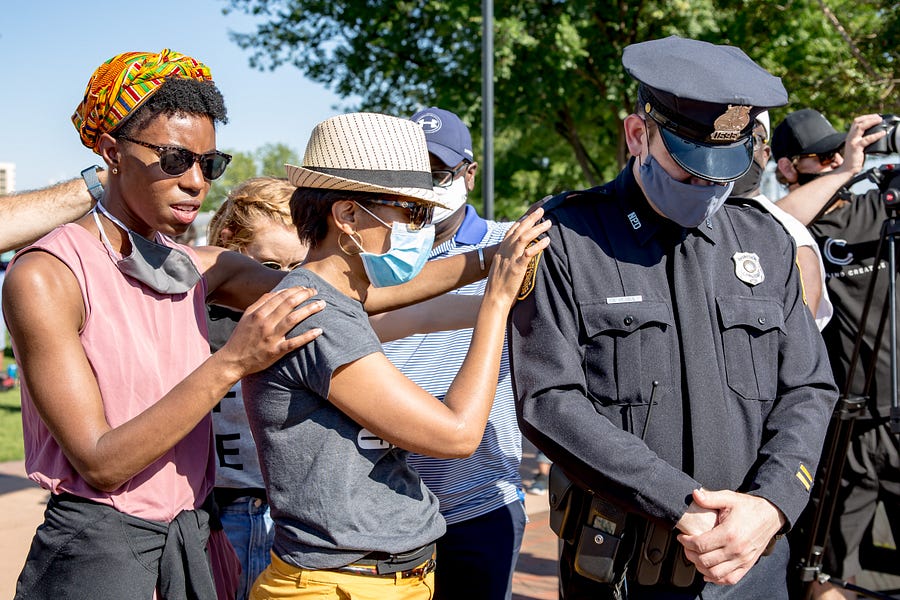The protests that sprang up in the wake of George Floyd’s killing were a response to a horrific event, but people weren’t protesting over just Floyd. The video that showed Chauvin refusing to get off his neck, and his colleagues looking on without intervention, was a watershed moment and even united the country in some respects, at least temporarily.
And now, nearly six years after Eric Garner told cops “I can’t breathe,” and nearly four years after Minneapolis police shot Philando Castile even as he told them he was not reaching for his gun, a consensus is emerging among a broad political spectrum that some sort of structural reform to local policing is necessary. South Carolina Sen. Tim Scott introduced the GOP’s police reform legislation, the JUSTICE Act, earlier this week, and the White House has issued an executive order broadly if vaguely encouraging (via funding) “best practices” by local law enforcement and sharing of information nationally on officer misconduct. On the Democratic side, civil rights groups and elected leaders tout the Obama-era Civil Rights Division’s “pattern and practice” consent decrees, which are entered into in federal courts against local police departments, as the kinds of federal intervention to be pursued.
And of course, on the extreme left the “Defund the Police” slogan has taken hold, albeit without much clarity about what it means. I do have to admit to a bit of schadenfreude watching national Democrats scramble to explain that the words “Defund the Police” don’t mean what they say—that it is just shorthand for “reform the police”—only to be undercut by activists and local liberal politicians in Minneapolis and elsewhere who essentially respond “Hell yeah, that’s exactly what we mean—‘defund the police’ as in eliminate police departments!” But for practical purposes (and despite President Trump’s attempt to hang the “Defund the Police” slogan on Joe Biden, who has rejected it) eliminating police is going nowhere as a national strategy to deal with structural policing reform.
As happens when any public policy issue jumps to the fore in the media, policing reform “hot takes” abound from all quarters. Fox News’s Sean Hannity recently proposed chokehold bans, dash cameras in every squad car, and body cameras on every officer. The Rayshard Brooks shooting at a Wendy’s in Atlanta has half the talking heads on cable discussing “proportionate” use of force policies and objecting to a firearm being used against a suspect who pointed “only” a “nonlethal” Taser at the officer. People with zero law enforcement experience are breaking down the various videos of the Brooks shooting like it is the Zapruder film and confidently opining that “there should be a rule” that at THAT point in the video the officer should have allowed Brooks to run away.
I’m not going to critique the various takes that people have—I have my own as well but I am humble enough to know that I am not an expert in police tactics and that such experts exist. But I did help manage the Department of Justice Civil Rights Division’s “pattern and practice” program for a couple of years and so had some experience meeting with and hearing the concerns of police chiefs, rank and file officers, community members, and other stakeholders about police reform. I also have some idea of what issues are likely to arise and what issues will need to be confronted as the nation and individual cities try to distill its intuition about what needs to change down to concrete policies.
Here are a few things to consider as you listen to the various proposals sure to come forward in the next weeks and months and consider what needs to happen in your city:
What is the Department of Justice’s role in local policing?
The overwhelming majority of law enforcement officers in this country are local, governed by local law, supervised by elected state, local, or county officials. Federal law enforcement, such as the FBI, the DEA, and the like, derive their authority from federal law to enforce federal statutes and stop federal crimes. Murder, rape, robbery, drunk driving, domestic violence, theft, and most of the crimes we think need “policing” are state level or local crimes.
So there is no inherent authority, under our federal system, for the federal government to control local law enforcement. Indeed, the Supreme Court has held in cases such as Printz v. United States that local law enforcement generally cannot be conscripted to enforce federal law.
This doesn’t mean there is no role for the federal government, just that that role is not plenary—the federal government cannot regulate local law enforcement the way the Occupational Health and Safety Administration (OSHA) might regulate workplace safety.
Where the federal government does have a role is in enforcing constitutional standards. Although the Bill of Rights initially applied only against the federal government, the “incorporation doctrine” generally applies constitutional standards to state and local actors. Thus, regardless of the terms of your state’s constitution, local law enforcement can no more violate your due process rights or your right to be free from unreasonable search and seizure than the federal government can.
Section 1983 of Title 42 of U.S. code provides individuals with the right to sue local officials for violations of their federal or constitutional rights. So a victim of excessive force, for example, will theoretically have a cause of action to recover money against a local policeman. (I’m leaving aside the judicially created “qualified immunity” doctrine that severely circumscribes that right for another day.) Congress, however, has also granted the DoJ the right to sue local law enforcement agencies in federal court and receive injunctive relief, via a federal consent decree, to remedy a “pattern-or-practice” of constitutional or federal violations.
Legal nerds will immediately see the jurisdictional issue—DoJ cannot roam the country and impose “best practices” on local law enforcement whenever it feels like it. It can, however, get an injunction changing local practices when those practices have led to a pattern or practice of constitutional violations. Traditionally, Republican administrations have taken this jurisdictional limitation seriously, and Democratic administrations less so.
Almost 20 years ago, I dealt with a department that had made a practice of pepper spraying detained suspects who were already in handcuffs if they mouthed off or threatened to spit at the officer. Officers disclosed that they did this on their use-of-force reporting, and supervisors signed off on the use of force as appropriate. This was a pattern of excessive force violations, and the DoJ had the statutory authority to change the policy via federal consent decree if needed. (The DoJ expert on the case also had the officers begin to carry painters masks to place on handcuffed suspects who threatened to spit on officers while being detained, which was often the event precipitating the unconstitutional capsaicin shot up the nose.) Narrow focus, tied to specific violations of constitutional standards.
In contrast, Democratic Justice Departments, often invited in by Democratic politicians who are less concerned with jurisdictional issues, have imposed lengthy consent decrees covering virtually every aspect of a given local department’s policing practices—from use of force and officer discipline policies, to canine policies, to record keeping and data collection. Chicago and Baltimore would be examples.
Mayors and police management often will not strenuously object to the DoJ imposing via consent decree wide-ranging reforms that they wouldn’t or couldn’t bargain for via collective bargaining with the local police union. But such decrees would be subject to legal challenge if not tied to a pattern or practice of constitutional violation. Moreover, as one might imagine, the rank-and-file union members often resent having work and discipline rules changed via such decrees rather than through collective bargaining, particularly if there hasn’t been a pattern or practice of constitutional misconduct established. The bottom line is you can write whatever policy you want, but what matters is what goes on in the street.
What that means is that DoJ pattern-and-practice authority is not a great vehicle to impose nationwide best practices because even under a Democratic administration that views the Department of Justice’s authority broadly, only a city or two at a time can be “reformed.” Rather, the pattern-and-practice program is best suited to impose constitutional standards on departments that have an established record of violating the constitution in specific ways and refuse to change. The DoJ can be an added incentive or hammer to drive reform in specific places that may have particular issues but can’t change the world.
What works?
One frustration about police reform issues is trying to judge what actually works, not how many “federal investigations were opened” or “consent decrees entered into.” If those metrics were predictive, we would have hit policing Shangri-La sometime during the Obama years, as the pattern-and-practice program was very active then. DoJ can impose the world’s best use of force policy on the Baltimore police, but did the process “work” if crime rates spike due to de-policing? Chicago already had many “progressive” policing policies prior to the LaQuan McDonald case, but that tragedy happened regardless and still more reforms were larded on in response. Even Minneapolis, where George Floyd died, has a chief viewed as a reformer and political leadership looking to implement modern use-of-force and other policies. So I’m not confident that the DoJ Civil Rights Division showing up with a spiffy new use of force policy and taking a top down approach to a troubled department works— but I am confident any real fixes are not quick.
My observation has been that, with respect to policing, culture and collaboration matter as much as, if not more than, specific policies and procedures. While I was at the DoJ in 2001, I negotiated a resolution of a Civil Rights Division pattern-and-practice investigation in Cincinnati, which had been beset by protests after several police-involved shootings. We did negotiate a Memorandum of Understanding (MOU) that required some policy changes by the police surrounding use of force and other practices, and thus required wrangling with police unions, the chief, the mayor, the ACLU, community groups, and others about what those changes would be and how they would be monitored. But that consultation and the MOU eventually gave way to what was known as the “Collaborative Agreement” pushed not by the DoJ, but to my recollection by the local ACLU’s lawyer, Al Gerhardstein. The collaborative process tried to approach community policing creatively, by placing all the stakeholders in a room to try to tackle the reasons for crime in certain neighborhoods and how best to fight it. The process required meetings every few weeks or months involving the police, the community, some advocates, legal pros, and others. Getting past distrust of each other and getting the police and community working together took many years—long after I was gone from the scene—but eventually police use-of-force rates dropped, crime rates fell, and police-community relations improved somewhat.
I don’t think any police reform effort can be deemed an unqualified success because the issues are too thorny and complex for that, but whatever progress was made by Cincinnati (and it’s been regarded as successful) was made by Cincinnatians. It wasn’t whatever policies we from the Justice Department mandated in our MOU that did the trick, it was the process and eventual trust among the community members and police that built up over time. The federal presence from DoJ was probably most useful as a facilitator (by forcing the issue early on and letting the police know they weren’t getting a pass notwithstanding a friendly relationship with the president and the AG) or later as a looming presence of possible intervention if the process cratered. Recall that George W. Bush was president and John Ashcroft was attorney general when that Collaborative Agreement process got started—so no jurisdiction facing problems today should think it needs to throw up its hands and give up to wait for a more “civil libertarian” federal administration to address policing issues if they really want to.
Rather, those cities looking at reform today would do well to talk with the participants in that process in Cincinnati and learn their lessons about building community, not necessarily their lessons about the text of the use-of-force policy, which they can research online.
Unfortunately, given the political desire for a quick fix, I don’t think people will want to hear what Cincinnati already knows about police reform—that it is hard, that it takes commitment, that it takes money, and that it can take years. And maybe the best you can hope for from the feds is some money, some support, and some structure for your efforts.
Bob Driscoll is chair of the White Collar and Government Investigations Group at McGlinchey in Washington, D.C., and a former deputy assistant attorney general for civil rights with the Department of Justice.
Photograph by Annette Holloway/Icon Sportswire/Getty Images.






Please note that we at The Dispatch hold ourselves, our work, and our commenters to a higher standard than other places on the internet. We welcome comments that foster genuine debate or discussion—including comments critical of us or our work—but responses that include ad hominem attacks on fellow Dispatch members or are intended to stoke fear and anger may be moderated.
With your membership, you only have the ability to comment on The Morning Dispatch articles. Consider upgrading to join the conversation everywhere.